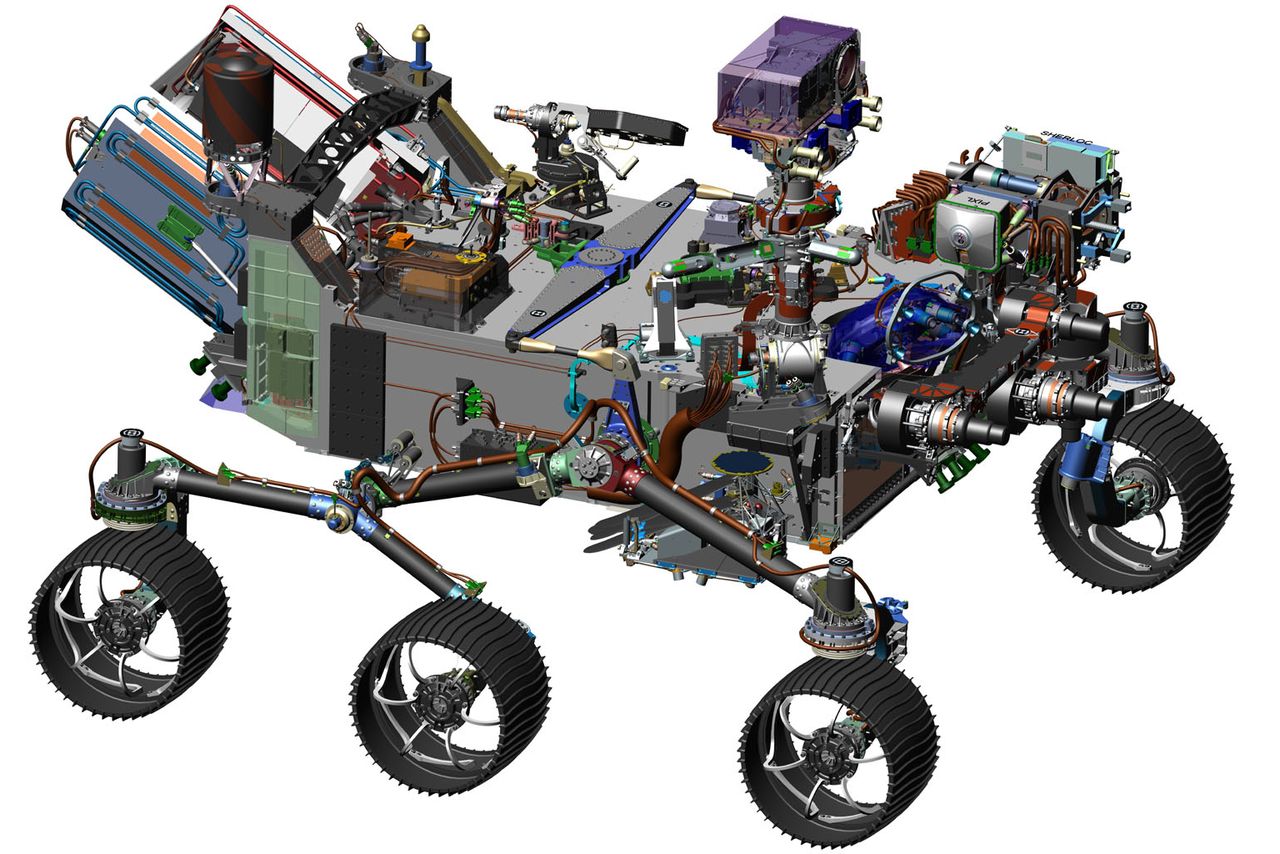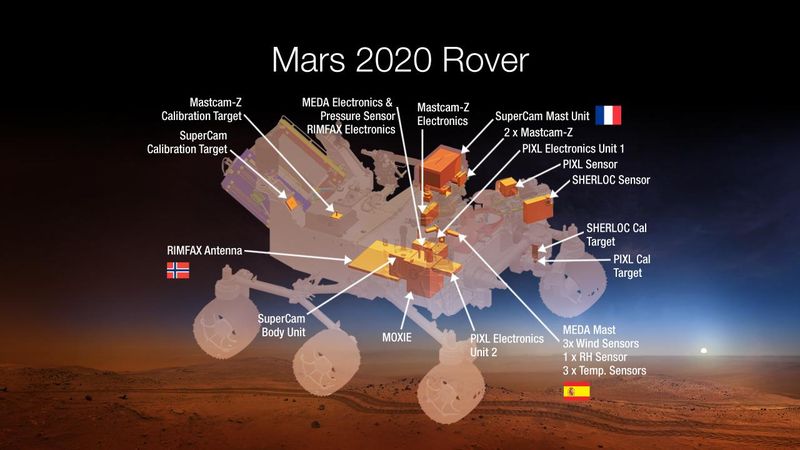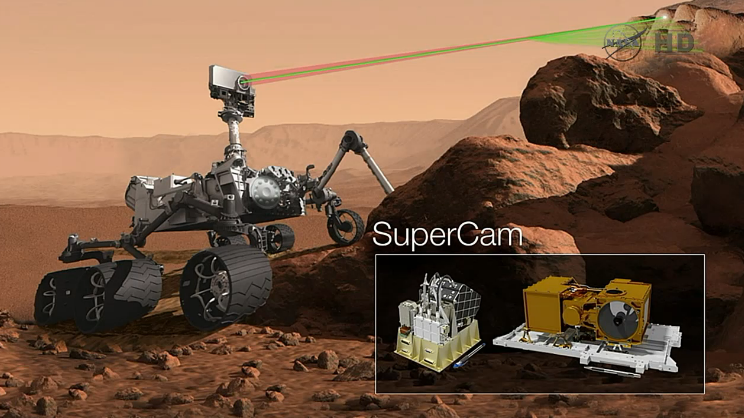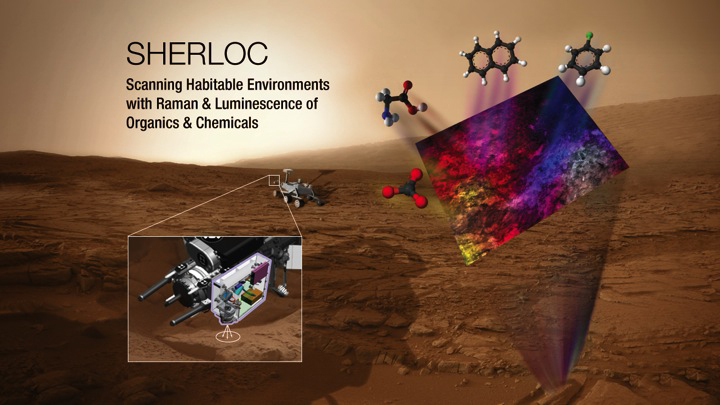The new NASA Mars 2020 rover will search for traces of life on the Red Planet
Recently, NASA spoke about the details of the new mission.

The question "Is there life on Mars?" Scientists still do not have an answer. Definitely, it could exist before. Perhaps it exists in one form or another now. But all this - assumptions and assumptions without a clear answer. In order to get this answer, NASA offers to send to Mars a new rover, called Mars 2020.
')
The agency has published a "roadmap" of the rover landing on Mars. So far, the date of the final stage of the journey is February 2021. Published and the image of the future rover. All stages of preliminary preparation for the project implementation have been completed.
The new stage involves the approval of the final version of the structure of the rover and the beginning of the manufacture of individual elements of the system. After all the parts have been manufactured, the assembly of the system will begin, its performance will be checked and the rover will be sent to the cosmodrome. The transition to this phase, according to project manager George Tau, should take place as early as next year.
Since the Mars 2020 mission is the “heiress” of the Curiosity mission, the structure and some elements of the new rover are very similar to what was used in Curiosity. Thanks to this, the scientists did not have to reinvent the bicycle, creating Mars 2020. Some parts and key components of the rover have already been made, since the technical basis has remained from the past project.
Model 2020 will collect samples of Mars soil and check them for signs of microbial life. This task was not assigned to Curiosity. Mars rover 2020 will also have to collect and save selected samples - this predecessor also did not. Samples are scheduled to be sent once to Earth for further verification. So far, there are no specific plans for this phase of the mission. “The mission of Mars 2020 is the first step in a multi-stage campaign to return collected and sealed images of Martian rocks. The mission is an important milestone in the implementation of the Journey to Mars program. The goal of the program is to determine whether life existed on Mars before ..., ”said Geoffrey Yoder, one of the leaders of the Mars 2020 program. 30 of the most interesting rock samples of Mars are planned to be selected and placed into sealed capsules.
It is known that the Mars 2020 rover will study one of the regions of the Red Planet, where, according to scientists, there was previously a favorable environment for the existence of microbial life. So far, the region is not defined - scientists are considering several likely places of interest in terms of research.

The Mars 2020 rover will have 7 basic scientific tools. The general equipment of a mars rover is better, than at Curiosity. The first tool is the main camera of the rover (the part that looks like the head of a robot). The camera is more advanced than the camera that was equipped with Curiosity. Mastcam-Z will be able to take panoramic pictures and stereoscopic images, like the camera model predecessor 2020. But she has a greater optical increase than the previous model. In fact, all Mars 2020 cameras are better than those of Curiosity, plus, besides the video, the rover can also record sound. And of course, the new rover will also be able to take a selfie.
The Model 2020 SuperCam is an enhanced version of ChemCam , the Curiosity tool. In fact, this is a powerful laser gun, which the rover will "shoot" on the rocks of Mars and analyze the resulting products. All this allows us to identify the mineral and understand the elementary composition of the rock. After receiving data on the analysis of rocks, Earth scientists will decide on the priorities for studying the various regions of Mars, where different rocks are deposited.

The third tool of the rover is MOXIE (Mars Oxygen ISRU Experiment). It will trap carbon dioxide and convert it into pure oxygen. This experiment will make it possible to understand whether future colonists on Mars will be able to get enough oxygen for the needs of the colony. Oxygen is also needed to create rocket fuel.
The fourth tool is MEDA Mars (Environmental Dynamics Analyzer). It is needed to study the Martian weather conditions. The sensors of the device will measure the temperature, wind speed and direction, pressure, relative humidity, size and shape of dust.
The fifth tool is RIFMAX. This is a georadar. He will be able to "look" under the surface of Mars to a depth of 10 meters ( some sources indicate 500 m) with a resolution of 5-20 centimeters. Thus, thanks to RIFMAX, scientists will receive a map of the surface layers of Mars in the region of the landing of the rover.
Planetary Instrument for X-ray Lithochemistry (PIXL) - X-ray fluorimetric spectrometer, which will also contain a high-resolution thermal imager to determine the composition of the Martian soil from rare elements. PIXL allows you to more accurately detect and analyze the elemental composition than was possible earlier.

Scanning Habitable Environments for Organics and Chemicals (SHERLOC) is an ultraviolet Raman spectrometer that will provide small-scale images to identify small-scale mineralogy and detect organic matter. SHERLOC will be the first ultraviolet spectrometer on the surface of Mars and will interact with other instruments in the payload.

After the announcement of the new program, NASA told about the details of the new mission. The organization also answered a number of questions from users who watched the presentation of the Mars 2020 mission. For example, NASA specialists will change the structure of the wheels of the rover in order to make them stronger than Curiosity wheels. As you know, this rover over time wheels received significant damage.
Undergo changes and landing system rover. The general landing pattern is the same as that of Curiosity. But experts can now determine on their own when it is necessary to open the parachute of the system, and not just the speed at which this parachute should open automatically. According to the developers of the system, this reduces the landing zone of the rover by half. As mentioned above, the rover camera can record and sound. The cameras will start working at the stage of descent of the device in order to record all the details.
If you wish, you can view the video presentation of the new system.

The question "Is there life on Mars?" Scientists still do not have an answer. Definitely, it could exist before. Perhaps it exists in one form or another now. But all this - assumptions and assumptions without a clear answer. In order to get this answer, NASA offers to send to Mars a new rover, called Mars 2020.
')
The agency has published a "roadmap" of the rover landing on Mars. So far, the date of the final stage of the journey is February 2021. Published and the image of the future rover. All stages of preliminary preparation for the project implementation have been completed.
The new stage involves the approval of the final version of the structure of the rover and the beginning of the manufacture of individual elements of the system. After all the parts have been manufactured, the assembly of the system will begin, its performance will be checked and the rover will be sent to the cosmodrome. The transition to this phase, according to project manager George Tau, should take place as early as next year.
Since the Mars 2020 mission is the “heiress” of the Curiosity mission, the structure and some elements of the new rover are very similar to what was used in Curiosity. Thanks to this, the scientists did not have to reinvent the bicycle, creating Mars 2020. Some parts and key components of the rover have already been made, since the technical basis has remained from the past project.
Model 2020 will collect samples of Mars soil and check them for signs of microbial life. This task was not assigned to Curiosity. Mars rover 2020 will also have to collect and save selected samples - this predecessor also did not. Samples are scheduled to be sent once to Earth for further verification. So far, there are no specific plans for this phase of the mission. “The mission of Mars 2020 is the first step in a multi-stage campaign to return collected and sealed images of Martian rocks. The mission is an important milestone in the implementation of the Journey to Mars program. The goal of the program is to determine whether life existed on Mars before ..., ”said Geoffrey Yoder, one of the leaders of the Mars 2020 program. 30 of the most interesting rock samples of Mars are planned to be selected and placed into sealed capsules.
It is known that the Mars 2020 rover will study one of the regions of the Red Planet, where, according to scientists, there was previously a favorable environment for the existence of microbial life. So far, the region is not defined - scientists are considering several likely places of interest in terms of research.

The Mars 2020 rover will have 7 basic scientific tools. The general equipment of a mars rover is better, than at Curiosity. The first tool is the main camera of the rover (the part that looks like the head of a robot). The camera is more advanced than the camera that was equipped with Curiosity. Mastcam-Z will be able to take panoramic pictures and stereoscopic images, like the camera model predecessor 2020. But she has a greater optical increase than the previous model. In fact, all Mars 2020 cameras are better than those of Curiosity, plus, besides the video, the rover can also record sound. And of course, the new rover will also be able to take a selfie.
The Model 2020 SuperCam is an enhanced version of ChemCam , the Curiosity tool. In fact, this is a powerful laser gun, which the rover will "shoot" on the rocks of Mars and analyze the resulting products. All this allows us to identify the mineral and understand the elementary composition of the rock. After receiving data on the analysis of rocks, Earth scientists will decide on the priorities for studying the various regions of Mars, where different rocks are deposited.

The third tool of the rover is MOXIE (Mars Oxygen ISRU Experiment). It will trap carbon dioxide and convert it into pure oxygen. This experiment will make it possible to understand whether future colonists on Mars will be able to get enough oxygen for the needs of the colony. Oxygen is also needed to create rocket fuel.
The fourth tool is MEDA Mars (Environmental Dynamics Analyzer). It is needed to study the Martian weather conditions. The sensors of the device will measure the temperature, wind speed and direction, pressure, relative humidity, size and shape of dust.
The fifth tool is RIFMAX. This is a georadar. He will be able to "look" under the surface of Mars to a depth of 10 meters ( some sources indicate 500 m) with a resolution of 5-20 centimeters. Thus, thanks to RIFMAX, scientists will receive a map of the surface layers of Mars in the region of the landing of the rover.
Planetary Instrument for X-ray Lithochemistry (PIXL) - X-ray fluorimetric spectrometer, which will also contain a high-resolution thermal imager to determine the composition of the Martian soil from rare elements. PIXL allows you to more accurately detect and analyze the elemental composition than was possible earlier.

Scanning Habitable Environments for Organics and Chemicals (SHERLOC) is an ultraviolet Raman spectrometer that will provide small-scale images to identify small-scale mineralogy and detect organic matter. SHERLOC will be the first ultraviolet spectrometer on the surface of Mars and will interact with other instruments in the payload.

After the announcement of the new program, NASA told about the details of the new mission. The organization also answered a number of questions from users who watched the presentation of the Mars 2020 mission. For example, NASA specialists will change the structure of the wheels of the rover in order to make them stronger than Curiosity wheels. As you know, this rover over time wheels received significant damage.
Undergo changes and landing system rover. The general landing pattern is the same as that of Curiosity. But experts can now determine on their own when it is necessary to open the parachute of the system, and not just the speed at which this parachute should open automatically. According to the developers of the system, this reduces the landing zone of the rover by half. As mentioned above, the rover camera can record and sound. The cameras will start working at the stage of descent of the device in order to record all the details.
If you wish, you can view the video presentation of the new system.
Source: https://habr.com/ru/post/396179/
All Articles